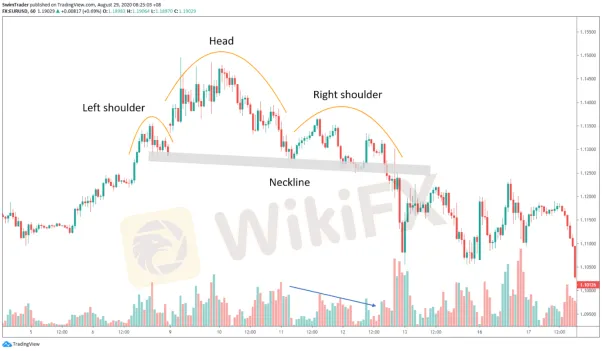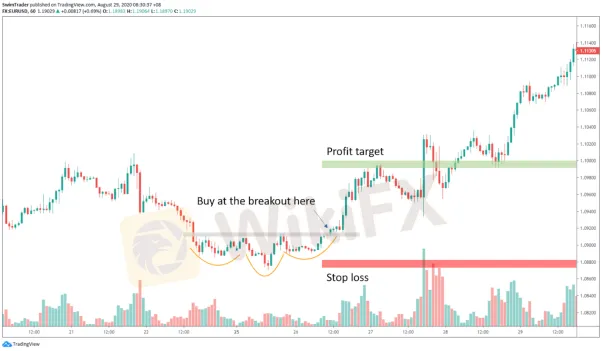简体中文
繁體中文
English
Pусский
日本語
ภาษาไทย
Tiếng Việt
Bahasa Indonesia
Español
हिन्दी
Filippiiniläinen
Français
Deutsch
Português
Türkçe
한국어
العربية
Powerful Top and Bottom Picking Secrets With Head And Shoulders| KOL Forex Analysis•Jay Tun
Abstract:The currency pair you’re watching crashed and quickly reverses. You don’t know if it is safe to enter just yet. You stay on the sidelines while many of your friends are making money trading the same currency pair. That is such a frustrating situation to be in.

The currency pair you‘re watching crashed and quickly reverses. You don’t know if it is safe to enter just yet. You stay on the sidelines while many of your friends are making money trading the same currency pair.
That is such a frustrating situation to be in.

You would want to be in the trade earlier than most participants to make more money and have boasting rights. When the crowd starts entering the same trade, you can smile at them because you have been in the green for a while now.
The question is how can you enter before the crowd? How do you know when to enter to avoid getting wiped out? Look out for the head and shoulderschart pattern. When you spot it, you can be confident that a reversal is on its way.
Lets use the most traded (also my favorite) currency pair as a case study - EUR/USD.
Spot It Right
#1 Market Tops
Besides the market structure, volume is also critical in assessing the chart patterns validity. It has to be declining at the right shoulder which is shown in the charts below.
The neckline of the head and shoulders chart pattern can be horizontally or sloping.
Knowing the above, what should this pattern look like?

· The “head” (peak) is surrounded by a “shoulder” (lower peak) on each side
o The shoulders dont have to be equal in height and breadth
· Volume is usually the heaviest at the left shoulder
· Volume continues to be heavy towards the head
· Volume is lower at the right shoulder
· A break in the neckline (you'll see it in the section Show Me The Money)
#2 Market Bottoms
At market bottoms, you‘ll see an inverted head and shoulders chart pattern instead. It is exactly the same as the head and shoulders chart pattern discussed above, just that it’s flipped upside down.
Lets have a look at how the inverted head and shoulders chart pattern should look like.

· The “head” (trough) is surrounded by a “shoulder” (shallower trough) on each side
o The shoulders dont have to be equal in depth and breadth
· Volume is usually the heaviest at the left shoulder
· Volume continues to be heavy towards the head
· Volume is lower at the right shoulder
· A break in the neckline (you'll see it in the section Show Me The Money)
Show Me The Money
#1 Breakout Trade


· Watch for price to break the neckline
· Enter your position according to the direction of the breakout
· Set your stop loss
· Set a profit target (based on the next support/resistance level)
#2 Pullback Trade


· Watch for price to break the neckline
· Wait for the price to pull back to the area near the neckline and enter your position
· Set your stop loss
· Set a profit target (based on the next support/resistance level)
Conclusion
It pays to wait for prices to form a pattern before entering after a crash because the first few rallies are usually deceiving.
When a currency pair is rallying and at a significant top, wait for a pattern to be formed to save you from all the agony and losses from buying the top.
「About The Author」
An independent trader who seeks to educate through his own trading
experiences, Jay began his own trading journey at the age of 22.
He is a self-taught trader who has read more than 200 books on
trading and investment since college and created his trading
methodologies modelling after several successful veteran traders.Jay has
since amassed 10 years of experience trading different market
conditions with consistency. Of the many disciplines in trading, he
specializes in trading options, swing trades on equities,
currencies,futures and contract-for-difference (CFDs).

WikiFX, a third-party forex broker inquiry platform, has collected
the information of 19,000+ forex brokers, 30 regulators, and helped
victims recover over 300,000,000.00 USD. WikiFX App provides functions
like forex brokers inquiry, calender, forex news express, calculator and
other trading tools to help you get trading done with ease.
Forex brokers inquiry: in order to create a safe forex trading
environment, WikiFX offers you two methods of checking the compliance of
forex brokers, online checking and offline investigation report. WikiFX
has an independent inspection team, conducting on-spot visit to brokers
offices to identify they are trustworthy or not.
Forex calender: the financial events which may affect forex trading
Forex news express: providing you the latest info anytime and anywhere
Forex forum: tons of posts by WikiFX users, containing technical
analysis, industry discussion, fraud brokers exposure; Users can
exchange their thoughts here freely.
Disclaimer:
The views in this article only represent the author's personal views, and do not constitute investment advice on this platform. This platform does not guarantee the accuracy, completeness and timeliness of the information in the article, and will not be liable for any loss caused by the use of or reliance on the information in the article.
Read more

Strong Yen against Hamstrung Yoshihide Suga| KOL Forex Analysis•Jasper Lo
Japan's Liberal Democratic Party (LDP) will elect a new leader to succeed the resigned Shinzo Abe as the next Prime Minister on September 14. This election, therefore, will be determined by the LDP factions rather than the country's public opinion. While Chief Cabinet Secretary Yoshihide Suga has taken a lead in the LDP's leadership race, he stressed to carry “Abenomics” forward with no novelty in his political platform.

Gbp/Jpy – Potential Bearishness inside a Long Term Ascending Channel|KOL Analysis•Jasper Njuguna
A Majority of market participants are net long on this pair and have sustained the bullish trend move since the start of the half year trading session during the year but seems a short term sell-off may portend.

USD/JPY Rising odds for a move higher!|KOL Analysis•Olimpiu Tuns
USD/JPY changed little in the last sessions waiting for a clear signal from JP225 and from the USDX. The Japanese Yen could lose more ground versus the dollar if the Nikkei will resume its upside movement.

EURUSD breaks 1.20 for the first time since 2018 Friday’s jobs data may determine what’s next|KOL
The pair has broken a psychological level unseen in over two years this week, but could the Fed be doing more harm than good to the dollar? This week, it’s all eyes on the employment data, and what impact -- if any -- it could have.
WikiFX Broker
Latest News
CWG Markets Got FSCA, South Africa Authorisation
Amazon launches Temu and Shein rival with \crazy low\ prices
CySEC Warns Against Unauthorized Investment Firms in Cyprus
JUST Finance and UBX Launch Multi-Currency Stablecoin Exchange
XM Revamps Website with Sleek Design and App Focus
TradingView & Mexico’s Uni. Partnership, to Enhance Financial Education
Something You Need to Know About SogoTrade
Global Shift in Cryptocurrency Taxation: Italy and Denmark Chart New Paths
Webull Introduces 24/5 Overnight Trading to Extend U.S. Market Access
eToro Launches Global-Edge Smart Portfolio: A Balanced Approach to Growth and Stability
Currency Calculator


